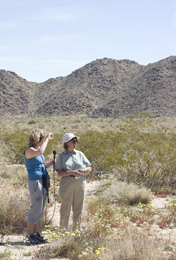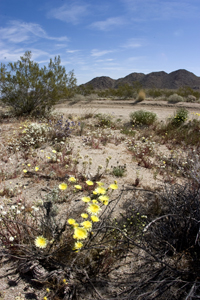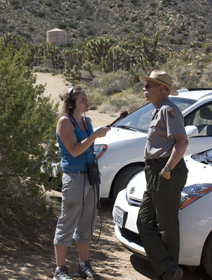The Joshua Tree At Risk
Air Date: Week of May 9, 2008

The Joshua Tree, quirky and beloved park mascot, is struggling to survive.
Nitrogen oxides - greenhouse gases from Los Angeles’ industrial ports and diesel truck exhaust - are making their way into the soils of Southeastern California. Living on Earth’s Ashley Ahearn went to Joshua Tree National Park to find out how air pollution is changing the desert ecosystem from the ground up.
Transcript
GELLERMAN: The Joshua Tree looks like something out of Dr Seuss. It’s got spiny pom-poms on the tips of its curved branches. One early explorer called it ‘the most repulsive plant in the vegetable kingdom.’ But it’s got its own national park in Southern California. Some researchers predict that climate change will force Joshua Trees North out of the park.

Route I-10 is a major trucking route from the L.A. industrial ports to the rest of the country. Nitrogen oxides from diesel truck fumes act like nitrate fertilizer when they get into the soil.
[TRUCKS ZOOM BY]
AHEARN: This is Route 10 East, coming out of L.A. headed towards Joshua Tree National Park. Alright, here we go, let’s get this guy. C’mon, c’mon.
[TRUCK HONKS]
AHEARN: Yessssss. Pretty much here following the trail of Nitrogen, among other greenhouse gases, that travel from the L.A. industrial ports out to Joshua Tree and end up deposited in the soil. And that’s what Dr. Edie Allen of UC Riverside studies.
[TRUCK ZOOMS BY]
[FOOTSTEPS IN DESERT SAND]
ALLEN: Let’s see, there’s some species of Lotus here.
AHEARN: About an hour later, I’m in the desert – Pinto Basin, Joshua Tree National Park – with Dr. Edie Allen. This is one of the sites where she’s studying what happens when nitrogen from air pollution gets into the soil. But right now, she’s talking plants – maybe one of her favorite things to do.

Dr. Edith Allen of University California Riverside stands with reporter Ashley Ahearn near one of her research plots in Joshua Tree National Park. Her team monitors nitrogen levels in the soil to understand their impacts on plant life.
AHEARN: Oh lizard, cool.
ALLEN: Yeah they’re all over.
AHEARN: What kind of lizard? Do you have any idea?
ALLEN: No, I have to admit, I’m just a hardcore botanist. (laughs)
AHEARN: Actually, Dr. Allen started out as a restoration ecologist, someone who researches how to repair polluted ecosystems. But it was in her research plots at UC Riverside, about an hour west of Joshua Tree National Park, that she realized she’d have to look to the sky to explain what she was seeing on the ground.
ALLEN: I found out that the nitrogen in the soil was so high that the only thing I could grow was weeds. I couldn’t grow the native plants, and so all of a sudden I had to become an air pollution ecologist too.

Desert Dandelions in Pinto Basin, Joshua Tree National Park.
In most places, nitrogen gets into the soil when rain comes down from clouds contaminated with nitrogen oxides. But it doesn’t rain that much here. So instead, Nitrogen oxide particles and ions settle on plant leaves during the dry season…
ALLEN: … and then the next winter rainy season those particles, or ions, are washed into the soil, where the plants can take them up when they start to grow, so it’s almost like adding a dry form of fertilizer.
AHEARN: Desert plants aren’t used to getting this extra nitrogen. But plants from elsewhere, grasses in particular, do really well with a little help in this dry climate.
ALLEN: The grass that I’m talking about is this one. This is called Mediterranean split grass, and it’s invaded our desert areas. It’s in the Mojave Desert. It’s in the Sonoran Desert. It’s become quite widespread.

Schismus Barbados growth near I-10 in a high Nitrogen area. (Photo: Dr. Edith Allen)
[SPEEDY GONZALES DARTING SOUND]
AHEARN: Speedy Gonzales cartoons helped form the way a lot of people picture the desert – sandy expanses punctuated with low shrubs, maybe a cactus here and there – perfect cover for darting roadrunners or mischievous mice.
Turns out, there’s a scientific name for these isolated oases of cover in the desert. Dr. Allen says underneath each shrub…
ALLEN: … is what we call an island of fertility. As I bend down here to pick up these grasses you can see that most of the plant material underneath the shrub is actually this Mediterranean split grass.

One of Dr. Allen's research plots in Pinto Basin. The dark red area marks new invasive growth where Dr. Allen applied the same amount of Nitrate fertilizer that a farmer in Ohio might apply to his wheat field. (Photo: Dr. Edith Allen)
So, for example, normally when lightning strikes a creosote bush in the desert, the fire burns out in that one bush’s island of fertility. But Mediterranean split grass fills in the gaps with fire fuel, allowing the fire to rip unimpeded from island to island.
The average size of a fire in Joshua Tree National Park today is 25 times what it was in the late ’70’s. Joe Zarki has worked for the Park Service here for the past 13 years. He remembers the Juniper Flats fire of 1999 – the biggest in park history.
ZARKI: That was a Memorial Day weekend fire, which really complicated the fire fighting efforts because the park was very busy, so we had to do an emergency evacuation of the entire western side of the park. So these fires that are caused, or at least the relationship with these fires and exotic grasses, are starting to have big time impacts on people as well as on the park and the ecosystem itself.

Long-time park ranger, Joe Zarki, remembers the Juniper Flats fire of 1999. 14,000 acres burned, the most in park history.
AHEARN: Zarki says the changing soil composition and plant life here are making it a lot harder for the charismatic park mascot to survive.
ZARKI: Thousands of Josh trees were burned in these fires and I think, you know, one of the concerns is Josh trees are a long lived plant so what we may be seeing is a pattern where they get burned up again before they ever reach a full mature size.
AHEARN: There’s also evidence that after fires, small mammals are eating the next generation of Joshua Tree seedlings.
But there’s some good news. Dr. Allen’s research suggests that if there were less nitrogen pollution in the air, nitrogen levels in the soil could go back to normal, allowing native wildflowers and plants to replace the Mediterranean split grass.
For Living on Earth, I’m Ashley Ahearn in Joshua Tree National Park, California.
Links
To learn more about Dr. Edith Allen's Research, click here
To read "Atmospheric Nitrogen Deposition: Implications for Park Managers"
Living on Earth wants to hear from you!
Living on Earth
62 Calef Highway, Suite 212
Lee, NH 03861
Telephone: 617-287-4121
E-mail: comments@loe.org
Newsletter [Click here]
Donate to Living on Earth!
Living on Earth is an independent media program and relies entirely on contributions from listeners and institutions supporting public service. Please donate now to preserve an independent environmental voice.
NewsletterLiving on Earth offers a weekly delivery of the show's rundown to your mailbox. Sign up for our newsletter today!
 Sailors For The Sea: Be the change you want to sea.
Sailors For The Sea: Be the change you want to sea.
 The Grantham Foundation for the Protection of the Environment: Committed to protecting and improving the health of the global environment.
The Grantham Foundation for the Protection of the Environment: Committed to protecting and improving the health of the global environment.
 Contribute to Living on Earth and receive, as our gift to you, an archival print of one of Mark Seth Lender's extraordinary wildlife photographs. Follow the link to see Mark's current collection of photographs.
Contribute to Living on Earth and receive, as our gift to you, an archival print of one of Mark Seth Lender's extraordinary wildlife photographs. Follow the link to see Mark's current collection of photographs.
 Buy a signed copy of Mark Seth Lender's book Smeagull the Seagull & support Living on Earth
Buy a signed copy of Mark Seth Lender's book Smeagull the Seagull & support Living on Earth

